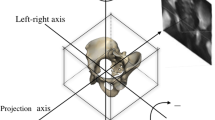Abstract
Although the ischial spine sign (ISS) has been advocated to detect acetabular retroversion, it is unknown whether the sign is valid on anteroposterior (AP) pelvic radiographs with tilted or rotated pelves. We therefore evaluated reliability of the ISS as a tool for diagnosing acetabular retroversion in the presence of considerable pelvic tilt and/or malrotation. We obtained radiographs of 20 cadaver pelves in 19 different malorientations resulting in 380 pelvis images (760 hips) for evaluation. In addition, 129 clinical radiographs of patients’ hips that had varying pelvis orientations were reviewed. We found an overall sensitivity of 81% (90%), specificity of 70% (71%), positive predictive value of 77% (80.7%), and negative predictive value of 75% (85%) in the cadaver (patient) hips. Our data suggest the ISS is a valid tool for diagnosing acetabular retroversion on plain radiographs taken using a standardized technique regardless of the degree of pelvic tilt and rotation.





Similar content being viewed by others
References
Clohisy JC, Carlisle JC, Trousdale R, Kim YJ, Beaule PE, Morgan P, Steger-May K, Schoenecker PL, Millis M. Radiographic evaluation of the hip has limited reliability. Clin Orthop Relat Res. 2009;467:666–675.
Drenckhahn D, Eckstein F. Lower extremity. In: Drenckhahn D, ed. Benninghoff Anatomy [in German]. München, Germany: Urban & Fischer; 2003:342–350.
Ganz R, Parvizi J, Beck M, Leunig M, Nötzli H, Siebenrock KA. Femoroacetabular impingement: a cause for osteoarthritis of the hip. Clin Orthop Relat Res. 2003;417:112–120.
Georgen TG, Resnik D. Evaluation of acetabular anteversion following total hip arthroplasty: necessity of proper centring. Br J Radiol. 1975;48:259–260.
Giori NJ, Trousdale RT. Acetabular retroversion is associated with osteoarthritis of the hip. Clin Orthop Relat Res. 2003;417:263–269.
Jamali AA, Mladenov K, Meyer DC, Martinez A, Beck M, Ganz R, Leunig M. Anteroposterior pelvic radiographs to assess acetabular retroversion: high validity of the ‘cross-over’ sign. J Orthop Res. 2007;25:758–765.
Kalberer F, Sierra RJ, Madan SS, Ganz R, Leunig M. Ischial spine projection into the pelvis: a new sign for acetabular retroversion. Clin Orthop Relat Res. 2008;466:677–683.
Köhnlein W, Ganz R, Impellizeri FM, Leunig M. Acetabular morphology: implications for joint-preserving surgery. Clin Orthop Relat Res. 2009;467:682–691.
Reynolds D, Lucas J, Klaue K. Retroversion of the acetabulum: a cause of hip pain. J Bone Joint Surg Br. 1999;81:281–288.
Siebenrock KA, Kalbermatten DF, Ganz R. Effect of pelvic tilt on acetabular retroversion: a study on cadavers. Clin Orthop Relat Res. 2003;407:241–248.
Tannast M, Mistry S, Steppacher SD, Reichenbach S, Langlotz F, Siebenrock KA, Zheng G. Radiographic analysis of femoroacetabular impingement with Hip2Norm: reliable and validated. J Orthop Res. 2008;26:1199–1205.
Tannast M, Siebenrock KA, Anderson SE. Femoroacetabular impingement: radiographic diagnosis–what the radiologist should know. AJR Am J Roentgenol. 2007;188:1540–1552.
Tannast M, Zheng G, Anderegg C, Burckhard K, Langlotz F, Ganz R, Siebenrock KA. Tilt and rotation correction of acetabular version on pelvic radiographs. Clin Orthop Relat Res. 2005;438:182–190.
Williams PL. The skeleton of the lower limb. In: Williams PL, Warkick R, Dyson M, Bannister LH, eds. Gray’s Anatomy. Edinburgh, Scotland: Churchill Livingstone; 1989:422–446.
Author information
Authors and Affiliations
Corresponding author
Additional information
One or more of the authors (KAS, MT) has received funding from the National Center for Competence in Research “Co-Me” of the Swiss National Science Foundation.
Each author certifies that his or her institution has approved the human protocol for this investigation and that all investigations were conducted in conformity with ethical principles of research.
This work was performed at the University of Bern, Bern, Switzerland.
An erratum to this article can be found at http://dx.doi.org/10.1007/s11999-010-1269-9
About this article
Cite this article
Kakaty, D.K., Fischer, A.F., Hosalkar, H.S. et al. The Ischial Spine Sign: Does Pelvic Tilt and Rotation Matter?. Clin Orthop Relat Res 468, 769–774 (2010). https://doi.org/10.1007/s11999-009-1021-5
Received:
Accepted:
Published:
Issue Date:
DOI: https://doi.org/10.1007/s11999-009-1021-5




